Healthy City: Factors Impacting Jeddah's Health and Quality of Life
VerifiedAdded on 2022/08/23
|19
|4246
|16
Report
AI Summary
This report investigates the factors that contribute to making Jeddah a healthy city, focusing on environmental quality and the quality of life for its residents. It begins with an introduction to Jeddah and highlights key problems such as pollution, inadequate sewage systems, traffic congestion, and water supply shortages. A literature review defines quality of life and its importance, exploring methods for measuring it and identifying best practices, including frameworks like the Quality of Life Program 2020 and QALY. The study sets goals to assess Jeddah's health and objectives to evaluate the quality of life index, identify factors affecting it, and suggest improvements. The methodology involves secondary data collection from existing literature. The problem definition includes building indicator measures, data collection, analysis, diagnosis, and recommendations to improve Jeddah's health and living conditions.
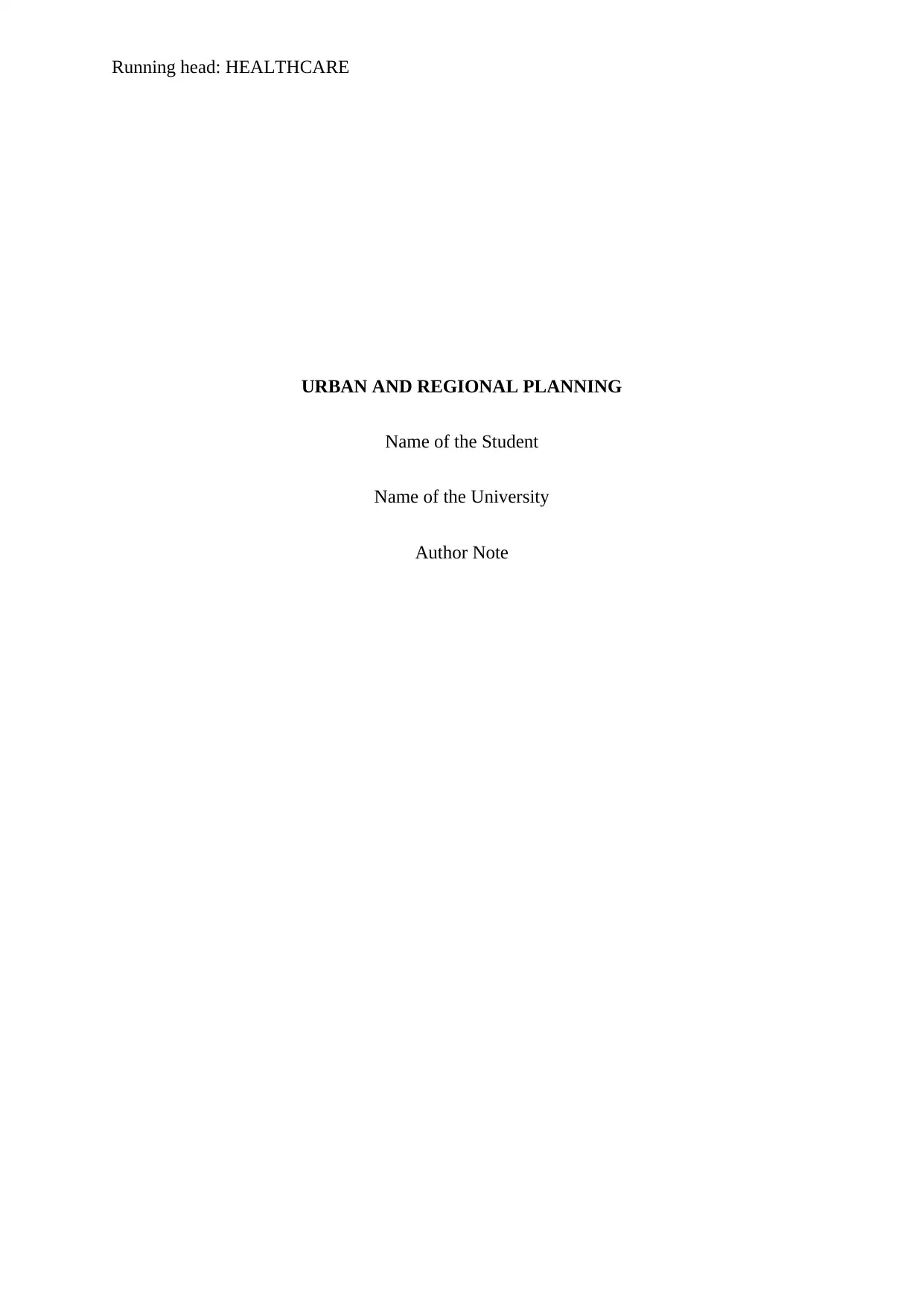
Running head: HEALTHCARE
URBAN AND REGIONAL PLANNING
Name of the Student
Name of the University
Author Note
URBAN AND REGIONAL PLANNING
Name of the Student
Name of the University
Author Note
Paraphrase This Document
Need a fresh take? Get an instant paraphrase of this document with our AI Paraphraser
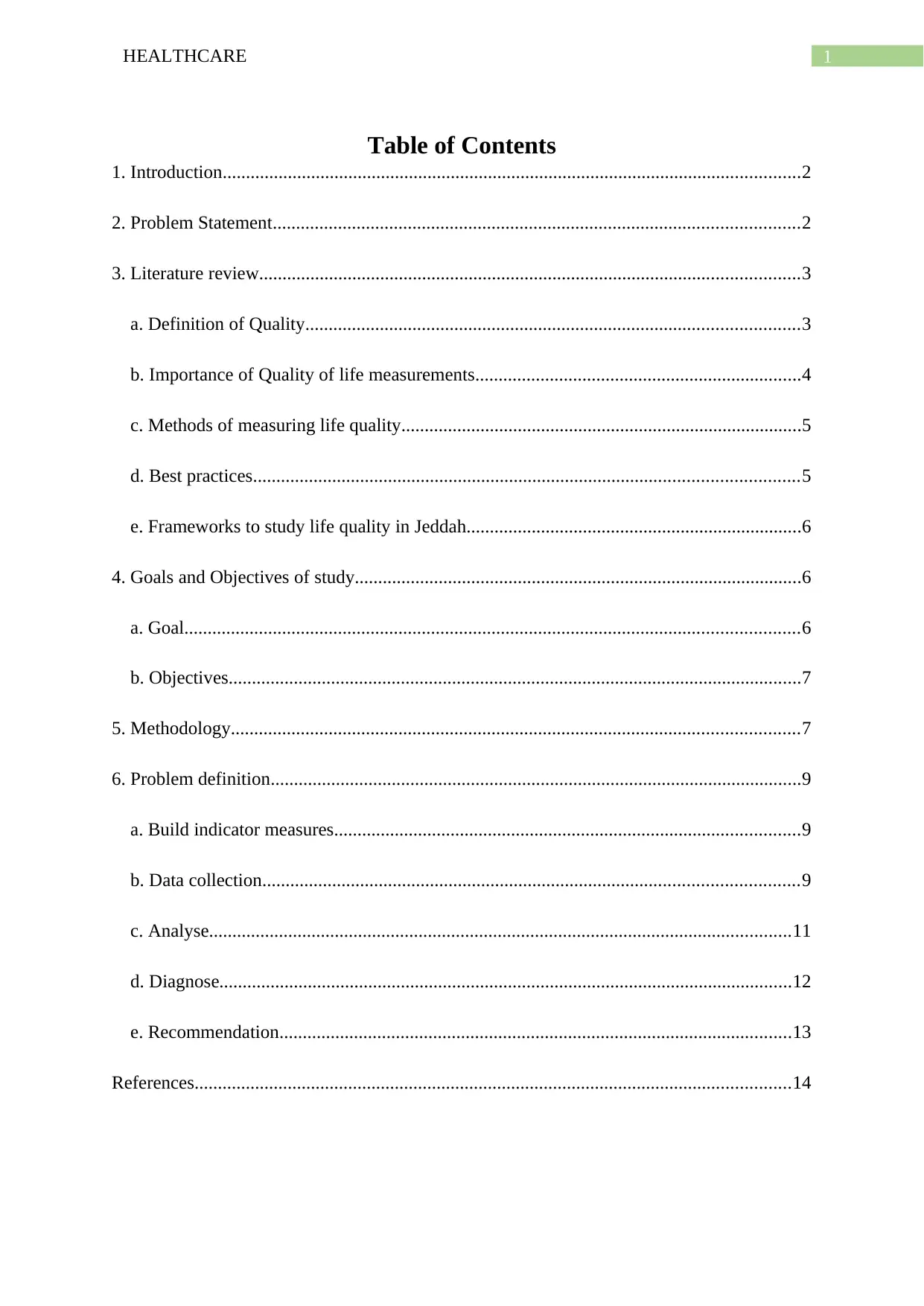
1HEALTHCARE
Table of Contents
1. Introduction............................................................................................................................2
2. Problem Statement.................................................................................................................2
3. Literature review....................................................................................................................3
a. Definition of Quality..........................................................................................................3
b. Importance of Quality of life measurements......................................................................4
c. Methods of measuring life quality......................................................................................5
d. Best practices.....................................................................................................................5
e. Frameworks to study life quality in Jeddah........................................................................6
4. Goals and Objectives of study................................................................................................6
a. Goal....................................................................................................................................6
b. Objectives...........................................................................................................................7
5. Methodology..........................................................................................................................7
6. Problem definition..................................................................................................................9
a. Build indicator measures....................................................................................................9
b. Data collection...................................................................................................................9
c. Analyse.............................................................................................................................11
d. Diagnose...........................................................................................................................12
e. Recommendation..............................................................................................................13
References................................................................................................................................14
Table of Contents
1. Introduction............................................................................................................................2
2. Problem Statement.................................................................................................................2
3. Literature review....................................................................................................................3
a. Definition of Quality..........................................................................................................3
b. Importance of Quality of life measurements......................................................................4
c. Methods of measuring life quality......................................................................................5
d. Best practices.....................................................................................................................5
e. Frameworks to study life quality in Jeddah........................................................................6
4. Goals and Objectives of study................................................................................................6
a. Goal....................................................................................................................................6
b. Objectives...........................................................................................................................7
5. Methodology..........................................................................................................................7
6. Problem definition..................................................................................................................9
a. Build indicator measures....................................................................................................9
b. Data collection...................................................................................................................9
c. Analyse.............................................................................................................................11
d. Diagnose...........................................................................................................................12
e. Recommendation..............................................................................................................13
References................................................................................................................................14

2HEALTHCARE
⊘ This is a preview!⊘
Do you want full access?
Subscribe today to unlock all pages.

Trusted by 1+ million students worldwide
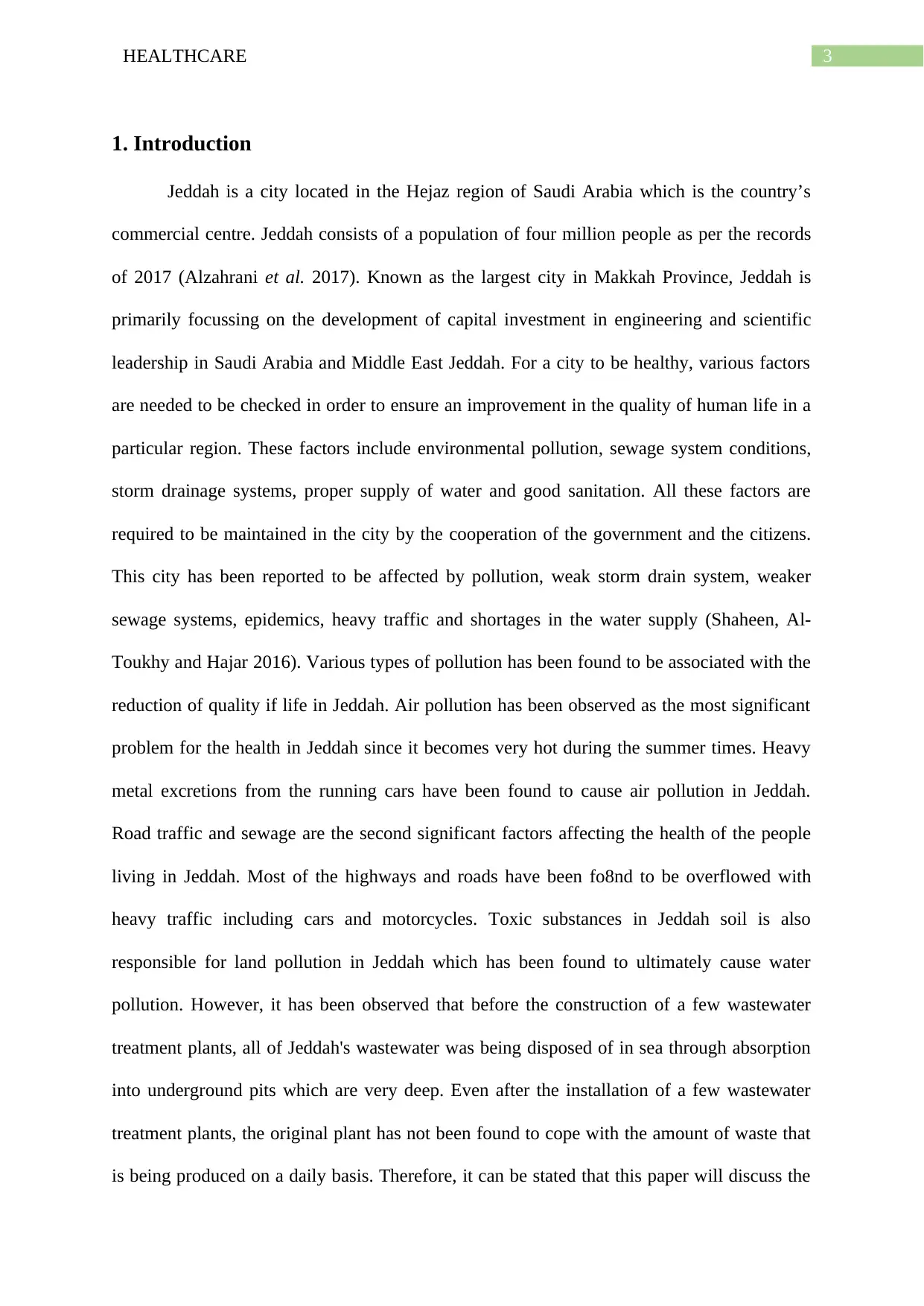
3HEALTHCARE
1. Introduction
Jeddah is a city located in the Hejaz region of Saudi Arabia which is the country’s
commercial centre. Jeddah consists of a population of four million people as per the records
of 2017 (Alzahrani et al. 2017). Known as the largest city in Makkah Province, Jeddah is
primarily focussing on the development of capital investment in engineering and scientific
leadership in Saudi Arabia and Middle East Jeddah. For a city to be healthy, various factors
are needed to be checked in order to ensure an improvement in the quality of human life in a
particular region. These factors include environmental pollution, sewage system conditions,
storm drainage systems, proper supply of water and good sanitation. All these factors are
required to be maintained in the city by the cooperation of the government and the citizens.
This city has been reported to be affected by pollution, weak storm drain system, weaker
sewage systems, epidemics, heavy traffic and shortages in the water supply (Shaheen, Al-
Toukhy and Hajar 2016). Various types of pollution has been found to be associated with the
reduction of quality if life in Jeddah. Air pollution has been observed as the most significant
problem for the health in Jeddah since it becomes very hot during the summer times. Heavy
metal excretions from the running cars have been found to cause air pollution in Jeddah.
Road traffic and sewage are the second significant factors affecting the health of the people
living in Jeddah. Most of the highways and roads have been fo8nd to be overflowed with
heavy traffic including cars and motorcycles. Toxic substances in Jeddah soil is also
responsible for land pollution in Jeddah which has been found to ultimately cause water
pollution. However, it has been observed that before the construction of a few wastewater
treatment plants, all of Jeddah's wastewater was being disposed of in sea through absorption
into underground pits which are very deep. Even after the installation of a few wastewater
treatment plants, the original plant has not been found to cope with the amount of waste that
is being produced on a daily basis. Therefore, it can be stated that this paper will discuss the
1. Introduction
Jeddah is a city located in the Hejaz region of Saudi Arabia which is the country’s
commercial centre. Jeddah consists of a population of four million people as per the records
of 2017 (Alzahrani et al. 2017). Known as the largest city in Makkah Province, Jeddah is
primarily focussing on the development of capital investment in engineering and scientific
leadership in Saudi Arabia and Middle East Jeddah. For a city to be healthy, various factors
are needed to be checked in order to ensure an improvement in the quality of human life in a
particular region. These factors include environmental pollution, sewage system conditions,
storm drainage systems, proper supply of water and good sanitation. All these factors are
required to be maintained in the city by the cooperation of the government and the citizens.
This city has been reported to be affected by pollution, weak storm drain system, weaker
sewage systems, epidemics, heavy traffic and shortages in the water supply (Shaheen, Al-
Toukhy and Hajar 2016). Various types of pollution has been found to be associated with the
reduction of quality if life in Jeddah. Air pollution has been observed as the most significant
problem for the health in Jeddah since it becomes very hot during the summer times. Heavy
metal excretions from the running cars have been found to cause air pollution in Jeddah.
Road traffic and sewage are the second significant factors affecting the health of the people
living in Jeddah. Most of the highways and roads have been fo8nd to be overflowed with
heavy traffic including cars and motorcycles. Toxic substances in Jeddah soil is also
responsible for land pollution in Jeddah which has been found to ultimately cause water
pollution. However, it has been observed that before the construction of a few wastewater
treatment plants, all of Jeddah's wastewater was being disposed of in sea through absorption
into underground pits which are very deep. Even after the installation of a few wastewater
treatment plants, the original plant has not been found to cope with the amount of waste that
is being produced on a daily basis. Therefore, it can be stated that this paper will discuss the
Paraphrase This Document
Need a fresh take? Get an instant paraphrase of this document with our AI Paraphraser
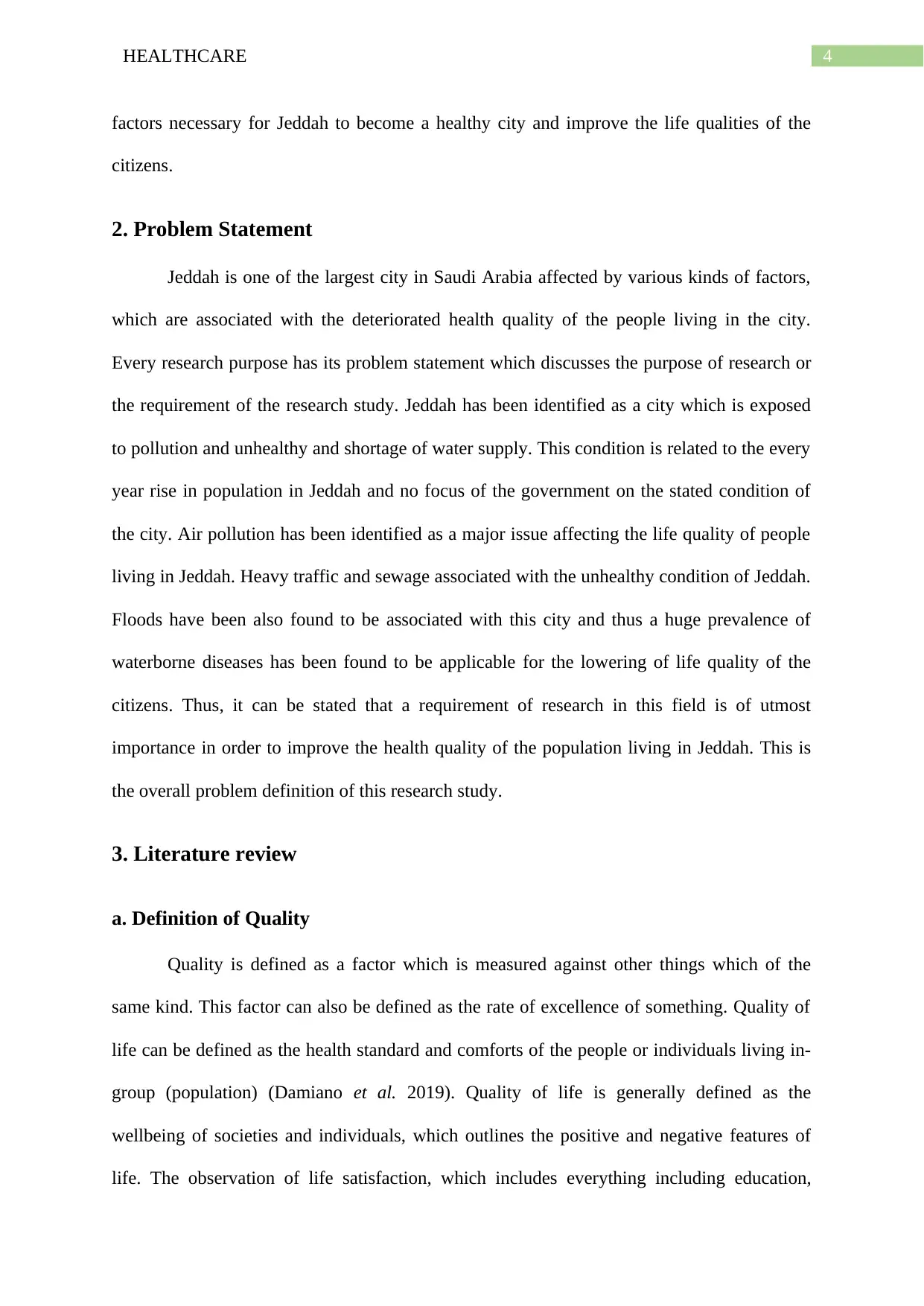
4HEALTHCARE
factors necessary for Jeddah to become a healthy city and improve the life qualities of the
citizens.
2. Problem Statement
Jeddah is one of the largest city in Saudi Arabia affected by various kinds of factors,
which are associated with the deteriorated health quality of the people living in the city.
Every research purpose has its problem statement which discusses the purpose of research or
the requirement of the research study. Jeddah has been identified as a city which is exposed
to pollution and unhealthy and shortage of water supply. This condition is related to the every
year rise in population in Jeddah and no focus of the government on the stated condition of
the city. Air pollution has been identified as a major issue affecting the life quality of people
living in Jeddah. Heavy traffic and sewage associated with the unhealthy condition of Jeddah.
Floods have been also found to be associated with this city and thus a huge prevalence of
waterborne diseases has been found to be applicable for the lowering of life quality of the
citizens. Thus, it can be stated that a requirement of research in this field is of utmost
importance in order to improve the health quality of the population living in Jeddah. This is
the overall problem definition of this research study.
3. Literature review
a. Definition of Quality
Quality is defined as a factor which is measured against other things which of the
same kind. This factor can also be defined as the rate of excellence of something. Quality of
life can be defined as the health standard and comforts of the people or individuals living in-
group (population) (Damiano et al. 2019). Quality of life is generally defined as the
wellbeing of societies and individuals, which outlines the positive and negative features of
life. The observation of life satisfaction, which includes everything including education,
factors necessary for Jeddah to become a healthy city and improve the life qualities of the
citizens.
2. Problem Statement
Jeddah is one of the largest city in Saudi Arabia affected by various kinds of factors,
which are associated with the deteriorated health quality of the people living in the city.
Every research purpose has its problem statement which discusses the purpose of research or
the requirement of the research study. Jeddah has been identified as a city which is exposed
to pollution and unhealthy and shortage of water supply. This condition is related to the every
year rise in population in Jeddah and no focus of the government on the stated condition of
the city. Air pollution has been identified as a major issue affecting the life quality of people
living in Jeddah. Heavy traffic and sewage associated with the unhealthy condition of Jeddah.
Floods have been also found to be associated with this city and thus a huge prevalence of
waterborne diseases has been found to be applicable for the lowering of life quality of the
citizens. Thus, it can be stated that a requirement of research in this field is of utmost
importance in order to improve the health quality of the population living in Jeddah. This is
the overall problem definition of this research study.
3. Literature review
a. Definition of Quality
Quality is defined as a factor which is measured against other things which of the
same kind. This factor can also be defined as the rate of excellence of something. Quality of
life can be defined as the health standard and comforts of the people or individuals living in-
group (population) (Damiano et al. 2019). Quality of life is generally defined as the
wellbeing of societies and individuals, which outlines the positive and negative features of
life. The observation of life satisfaction, which includes everything including education,
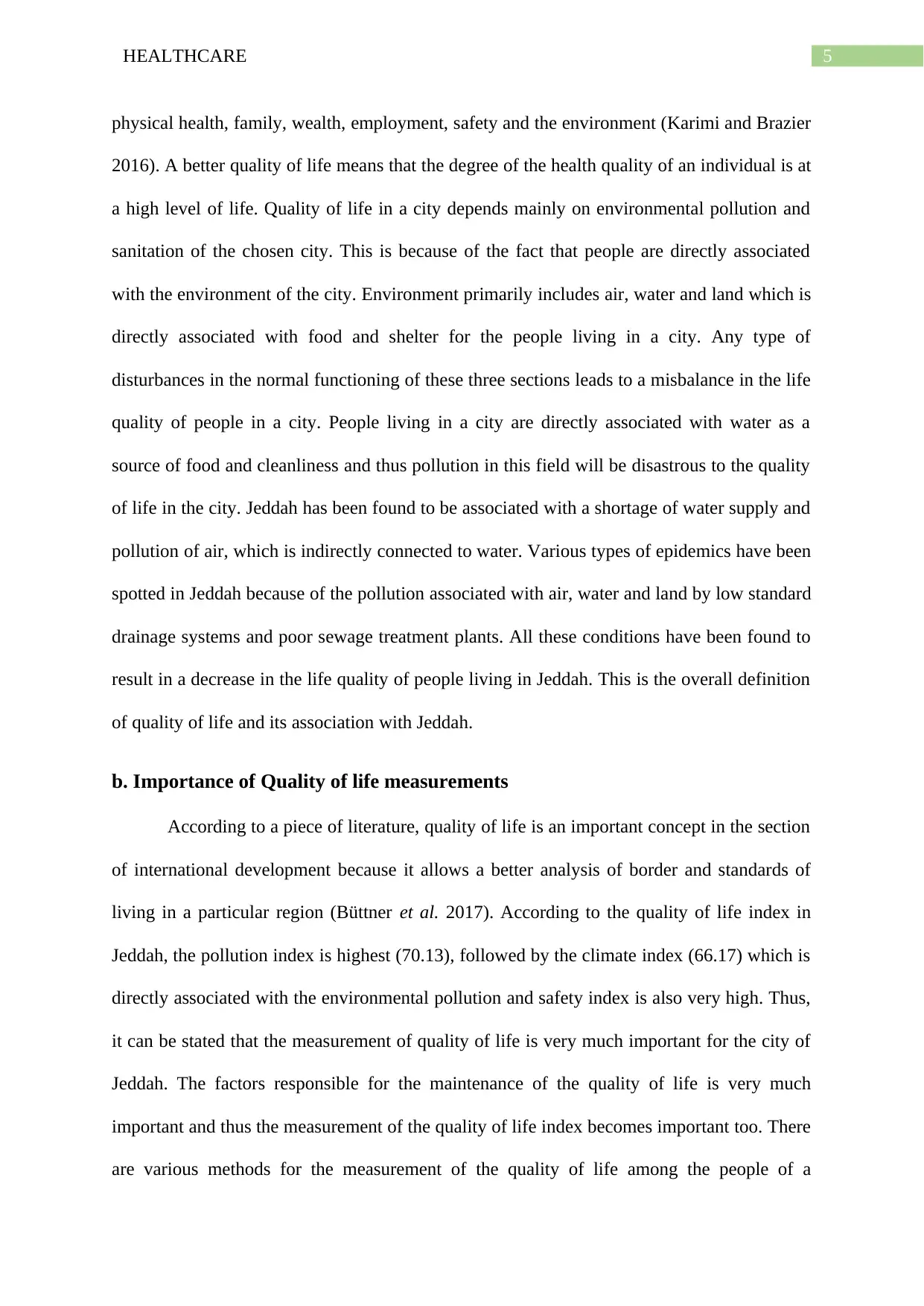
5HEALTHCARE
physical health, family, wealth, employment, safety and the environment (Karimi and Brazier
2016). A better quality of life means that the degree of the health quality of an individual is at
a high level of life. Quality of life in a city depends mainly on environmental pollution and
sanitation of the chosen city. This is because of the fact that people are directly associated
with the environment of the city. Environment primarily includes air, water and land which is
directly associated with food and shelter for the people living in a city. Any type of
disturbances in the normal functioning of these three sections leads to a misbalance in the life
quality of people in a city. People living in a city are directly associated with water as a
source of food and cleanliness and thus pollution in this field will be disastrous to the quality
of life in the city. Jeddah has been found to be associated with a shortage of water supply and
pollution of air, which is indirectly connected to water. Various types of epidemics have been
spotted in Jeddah because of the pollution associated with air, water and land by low standard
drainage systems and poor sewage treatment plants. All these conditions have been found to
result in a decrease in the life quality of people living in Jeddah. This is the overall definition
of quality of life and its association with Jeddah.
b. Importance of Quality of life measurements
According to a piece of literature, quality of life is an important concept in the section
of international development because it allows a better analysis of border and standards of
living in a particular region (Büttner et al. 2017). According to the quality of life index in
Jeddah, the pollution index is highest (70.13), followed by the climate index (66.17) which is
directly associated with the environmental pollution and safety index is also very high. Thus,
it can be stated that the measurement of quality of life is very much important for the city of
Jeddah. The factors responsible for the maintenance of the quality of life is very much
important and thus the measurement of the quality of life index becomes important too. There
are various methods for the measurement of the quality of life among the people of a
physical health, family, wealth, employment, safety and the environment (Karimi and Brazier
2016). A better quality of life means that the degree of the health quality of an individual is at
a high level of life. Quality of life in a city depends mainly on environmental pollution and
sanitation of the chosen city. This is because of the fact that people are directly associated
with the environment of the city. Environment primarily includes air, water and land which is
directly associated with food and shelter for the people living in a city. Any type of
disturbances in the normal functioning of these three sections leads to a misbalance in the life
quality of people in a city. People living in a city are directly associated with water as a
source of food and cleanliness and thus pollution in this field will be disastrous to the quality
of life in the city. Jeddah has been found to be associated with a shortage of water supply and
pollution of air, which is indirectly connected to water. Various types of epidemics have been
spotted in Jeddah because of the pollution associated with air, water and land by low standard
drainage systems and poor sewage treatment plants. All these conditions have been found to
result in a decrease in the life quality of people living in Jeddah. This is the overall definition
of quality of life and its association with Jeddah.
b. Importance of Quality of life measurements
According to a piece of literature, quality of life is an important concept in the section
of international development because it allows a better analysis of border and standards of
living in a particular region (Büttner et al. 2017). According to the quality of life index in
Jeddah, the pollution index is highest (70.13), followed by the climate index (66.17) which is
directly associated with the environmental pollution and safety index is also very high. Thus,
it can be stated that the measurement of quality of life is very much important for the city of
Jeddah. The factors responsible for the maintenance of the quality of life is very much
important and thus the measurement of the quality of life index becomes important too. There
are various methods for the measurement of the quality of life among the people of a
⊘ This is a preview!⊘
Do you want full access?
Subscribe today to unlock all pages.

Trusted by 1+ million students worldwide
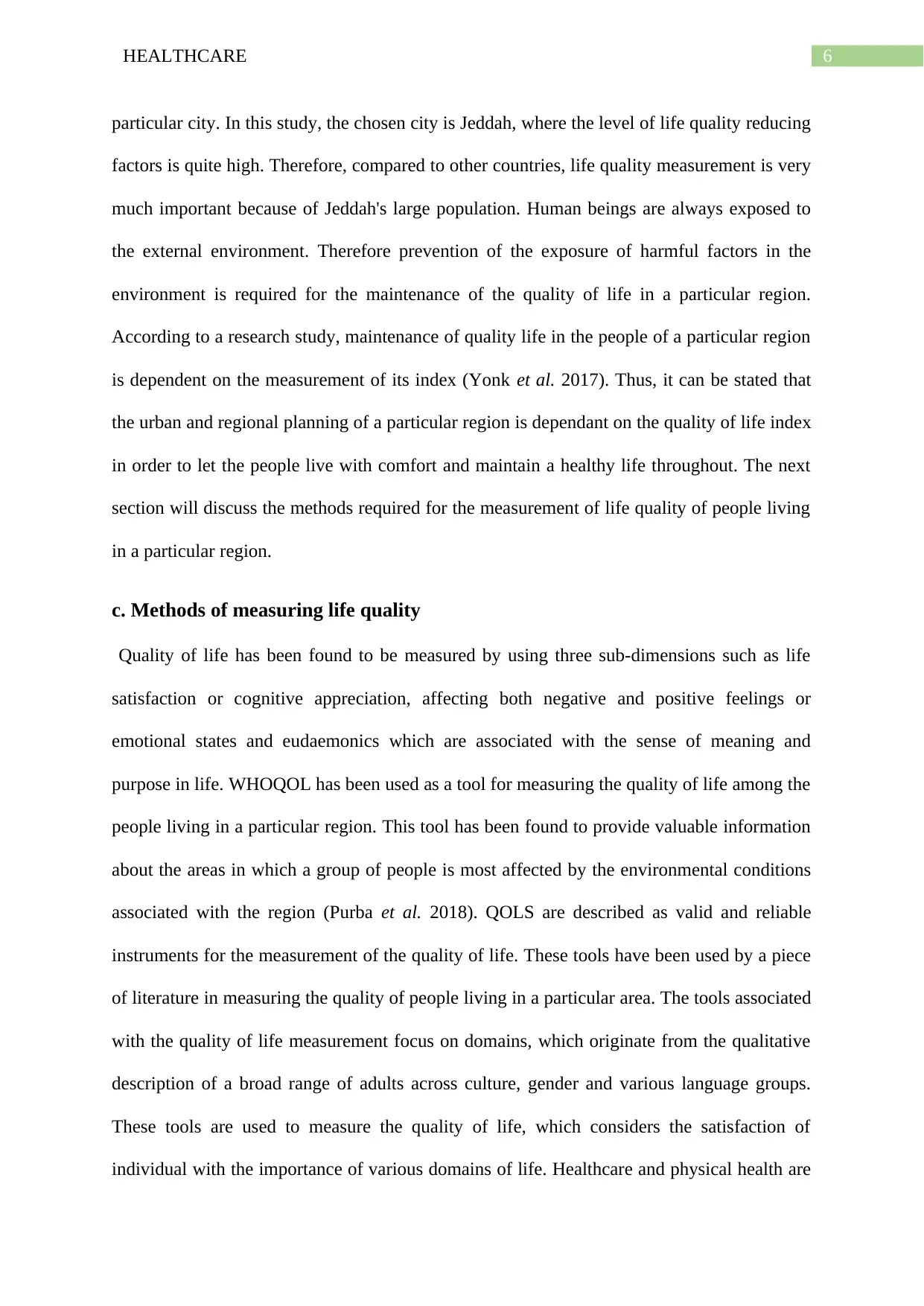
6HEALTHCARE
particular city. In this study, the chosen city is Jeddah, where the level of life quality reducing
factors is quite high. Therefore, compared to other countries, life quality measurement is very
much important because of Jeddah's large population. Human beings are always exposed to
the external environment. Therefore prevention of the exposure of harmful factors in the
environment is required for the maintenance of the quality of life in a particular region.
According to a research study, maintenance of quality life in the people of a particular region
is dependent on the measurement of its index (Yonk et al. 2017). Thus, it can be stated that
the urban and regional planning of a particular region is dependant on the quality of life index
in order to let the people live with comfort and maintain a healthy life throughout. The next
section will discuss the methods required for the measurement of life quality of people living
in a particular region.
c. Methods of measuring life quality
Quality of life has been found to be measured by using three sub-dimensions such as life
satisfaction or cognitive appreciation, affecting both negative and positive feelings or
emotional states and eudaemonics which are associated with the sense of meaning and
purpose in life. WHOQOL has been used as a tool for measuring the quality of life among the
people living in a particular region. This tool has been found to provide valuable information
about the areas in which a group of people is most affected by the environmental conditions
associated with the region (Purba et al. 2018). QOLS are described as valid and reliable
instruments for the measurement of the quality of life. These tools have been used by a piece
of literature in measuring the quality of people living in a particular area. The tools associated
with the quality of life measurement focus on domains, which originate from the qualitative
description of a broad range of adults across culture, gender and various language groups.
These tools are used to measure the quality of life, which considers the satisfaction of
individual with the importance of various domains of life. Healthcare and physical health are
particular city. In this study, the chosen city is Jeddah, where the level of life quality reducing
factors is quite high. Therefore, compared to other countries, life quality measurement is very
much important because of Jeddah's large population. Human beings are always exposed to
the external environment. Therefore prevention of the exposure of harmful factors in the
environment is required for the maintenance of the quality of life in a particular region.
According to a research study, maintenance of quality life in the people of a particular region
is dependent on the measurement of its index (Yonk et al. 2017). Thus, it can be stated that
the urban and regional planning of a particular region is dependant on the quality of life index
in order to let the people live with comfort and maintain a healthy life throughout. The next
section will discuss the methods required for the measurement of life quality of people living
in a particular region.
c. Methods of measuring life quality
Quality of life has been found to be measured by using three sub-dimensions such as life
satisfaction or cognitive appreciation, affecting both negative and positive feelings or
emotional states and eudaemonics which are associated with the sense of meaning and
purpose in life. WHOQOL has been used as a tool for measuring the quality of life among the
people living in a particular region. This tool has been found to provide valuable information
about the areas in which a group of people is most affected by the environmental conditions
associated with the region (Purba et al. 2018). QOLS are described as valid and reliable
instruments for the measurement of the quality of life. These tools have been used by a piece
of literature in measuring the quality of people living in a particular area. The tools associated
with the quality of life measurement focus on domains, which originate from the qualitative
description of a broad range of adults across culture, gender and various language groups.
These tools are used to measure the quality of life, which considers the satisfaction of
individual with the importance of various domains of life. Healthcare and physical health are
Paraphrase This Document
Need a fresh take? Get an instant paraphrase of this document with our AI Paraphraser
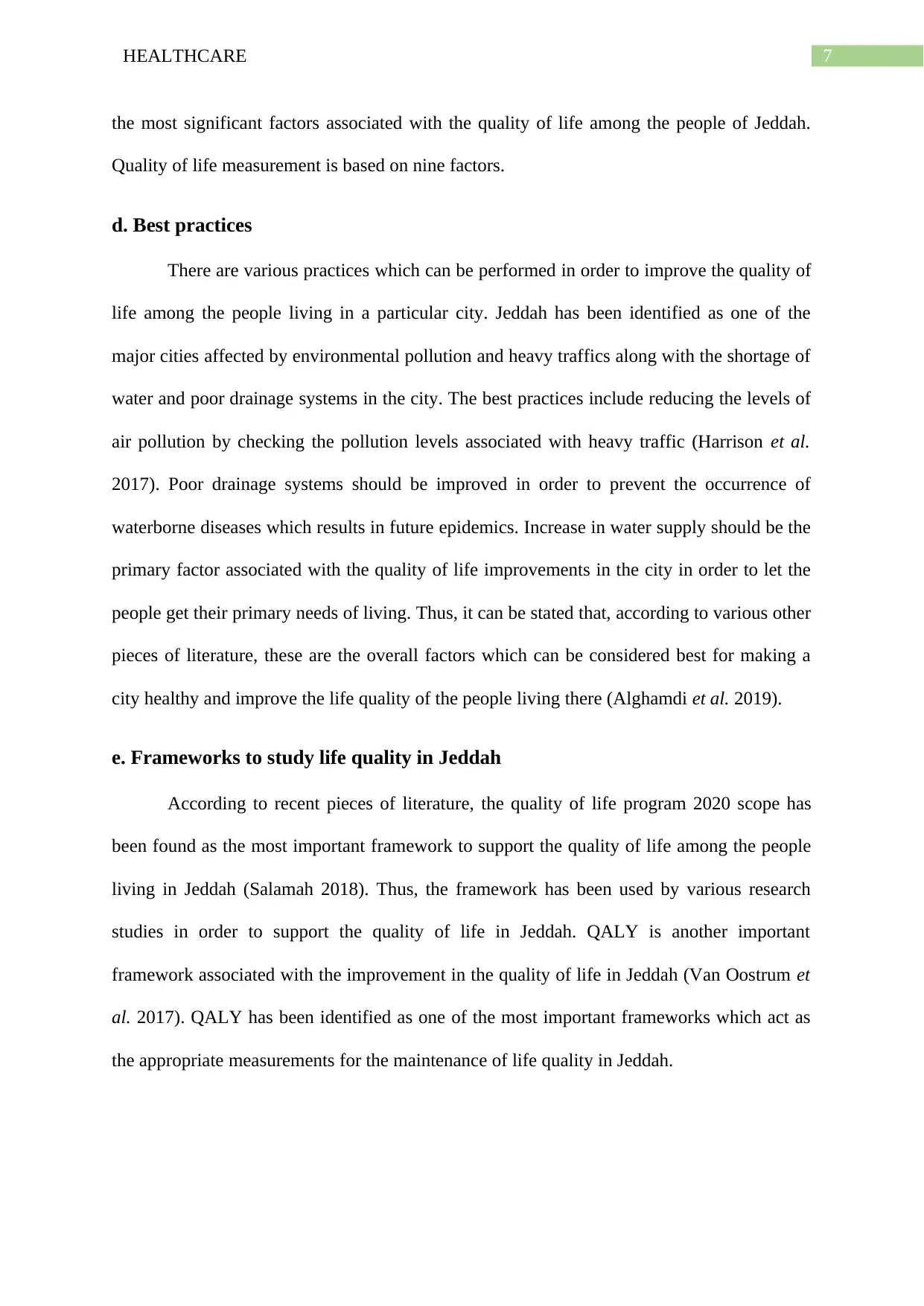
7HEALTHCARE
the most significant factors associated with the quality of life among the people of Jeddah.
Quality of life measurement is based on nine factors.
d. Best practices
There are various practices which can be performed in order to improve the quality of
life among the people living in a particular city. Jeddah has been identified as one of the
major cities affected by environmental pollution and heavy traffics along with the shortage of
water and poor drainage systems in the city. The best practices include reducing the levels of
air pollution by checking the pollution levels associated with heavy traffic (Harrison et al.
2017). Poor drainage systems should be improved in order to prevent the occurrence of
waterborne diseases which results in future epidemics. Increase in water supply should be the
primary factor associated with the quality of life improvements in the city in order to let the
people get their primary needs of living. Thus, it can be stated that, according to various other
pieces of literature, these are the overall factors which can be considered best for making a
city healthy and improve the life quality of the people living there (Alghamdi et al. 2019).
e. Frameworks to study life quality in Jeddah
According to recent pieces of literature, the quality of life program 2020 scope has
been found as the most important framework to support the quality of life among the people
living in Jeddah (Salamah 2018). Thus, the framework has been used by various research
studies in order to support the quality of life in Jeddah. QALY is another important
framework associated with the improvement in the quality of life in Jeddah (Van Oostrum et
al. 2017). QALY has been identified as one of the most important frameworks which act as
the appropriate measurements for the maintenance of life quality in Jeddah.
the most significant factors associated with the quality of life among the people of Jeddah.
Quality of life measurement is based on nine factors.
d. Best practices
There are various practices which can be performed in order to improve the quality of
life among the people living in a particular city. Jeddah has been identified as one of the
major cities affected by environmental pollution and heavy traffics along with the shortage of
water and poor drainage systems in the city. The best practices include reducing the levels of
air pollution by checking the pollution levels associated with heavy traffic (Harrison et al.
2017). Poor drainage systems should be improved in order to prevent the occurrence of
waterborne diseases which results in future epidemics. Increase in water supply should be the
primary factor associated with the quality of life improvements in the city in order to let the
people get their primary needs of living. Thus, it can be stated that, according to various other
pieces of literature, these are the overall factors which can be considered best for making a
city healthy and improve the life quality of the people living there (Alghamdi et al. 2019).
e. Frameworks to study life quality in Jeddah
According to recent pieces of literature, the quality of life program 2020 scope has
been found as the most important framework to support the quality of life among the people
living in Jeddah (Salamah 2018). Thus, the framework has been used by various research
studies in order to support the quality of life in Jeddah. QALY is another important
framework associated with the improvement in the quality of life in Jeddah (Van Oostrum et
al. 2017). QALY has been identified as one of the most important frameworks which act as
the appropriate measurements for the maintenance of life quality in Jeddah.
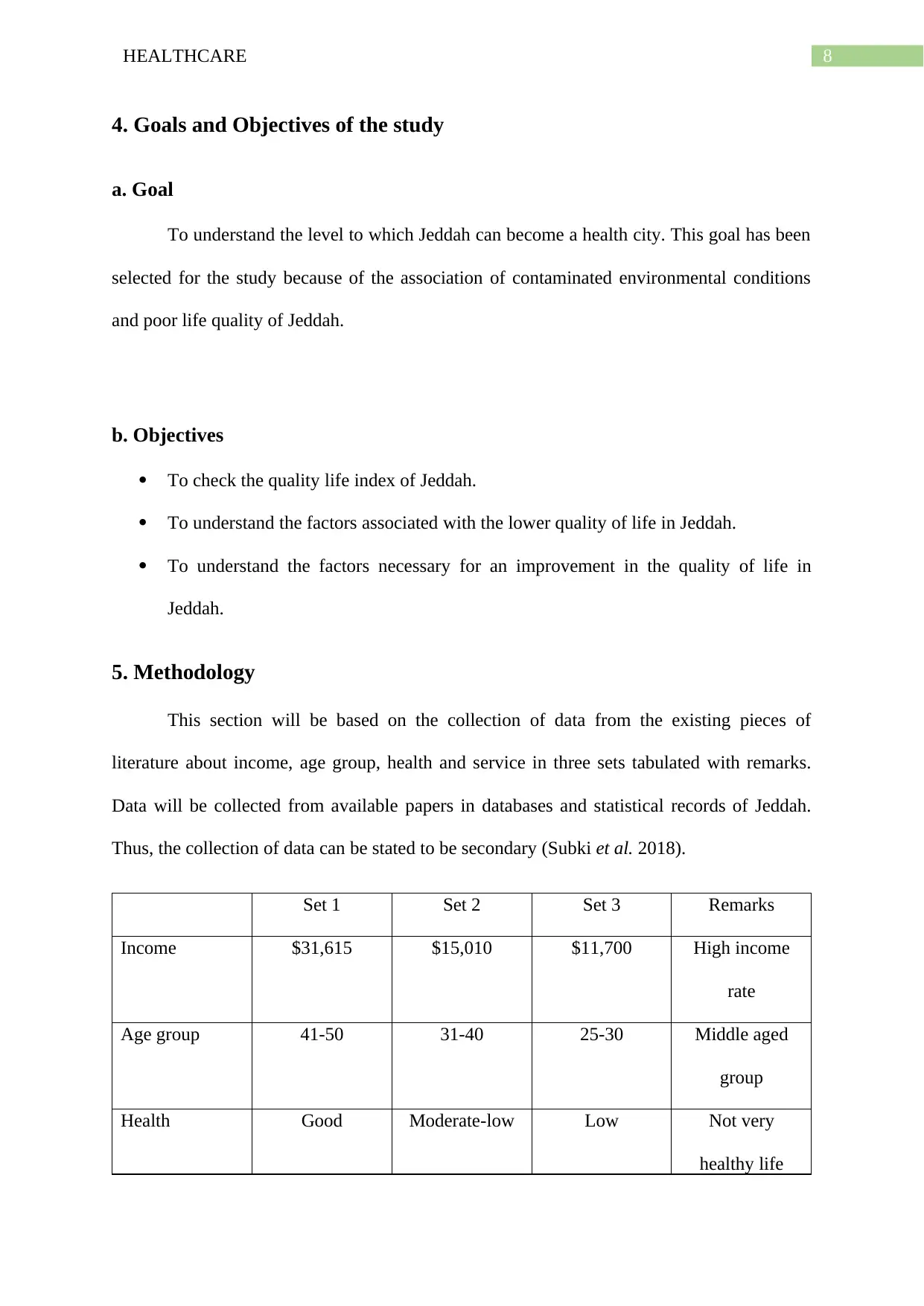
8HEALTHCARE
4. Goals and Objectives of the study
a. Goal
To understand the level to which Jeddah can become a health city. This goal has been
selected for the study because of the association of contaminated environmental conditions
and poor life quality of Jeddah.
b. Objectives
To check the quality life index of Jeddah.
To understand the factors associated with the lower quality of life in Jeddah.
To understand the factors necessary for an improvement in the quality of life in
Jeddah.
5. Methodology
This section will be based on the collection of data from the existing pieces of
literature about income, age group, health and service in three sets tabulated with remarks.
Data will be collected from available papers in databases and statistical records of Jeddah.
Thus, the collection of data can be stated to be secondary (Subki et al. 2018).
Set 1 Set 2 Set 3 Remarks
Income $31,615 $15,010 $11,700 High income
rate
Age group 41-50 31-40 25-30 Middle aged
group
Health Good Moderate-low Low Not very
healthy life
4. Goals and Objectives of the study
a. Goal
To understand the level to which Jeddah can become a health city. This goal has been
selected for the study because of the association of contaminated environmental conditions
and poor life quality of Jeddah.
b. Objectives
To check the quality life index of Jeddah.
To understand the factors associated with the lower quality of life in Jeddah.
To understand the factors necessary for an improvement in the quality of life in
Jeddah.
5. Methodology
This section will be based on the collection of data from the existing pieces of
literature about income, age group, health and service in three sets tabulated with remarks.
Data will be collected from available papers in databases and statistical records of Jeddah.
Thus, the collection of data can be stated to be secondary (Subki et al. 2018).
Set 1 Set 2 Set 3 Remarks
Income $31,615 $15,010 $11,700 High income
rate
Age group 41-50 31-40 25-30 Middle aged
group
Health Good Moderate-low Low Not very
healthy life
⊘ This is a preview!⊘
Do you want full access?
Subscribe today to unlock all pages.

Trusted by 1+ million students worldwide
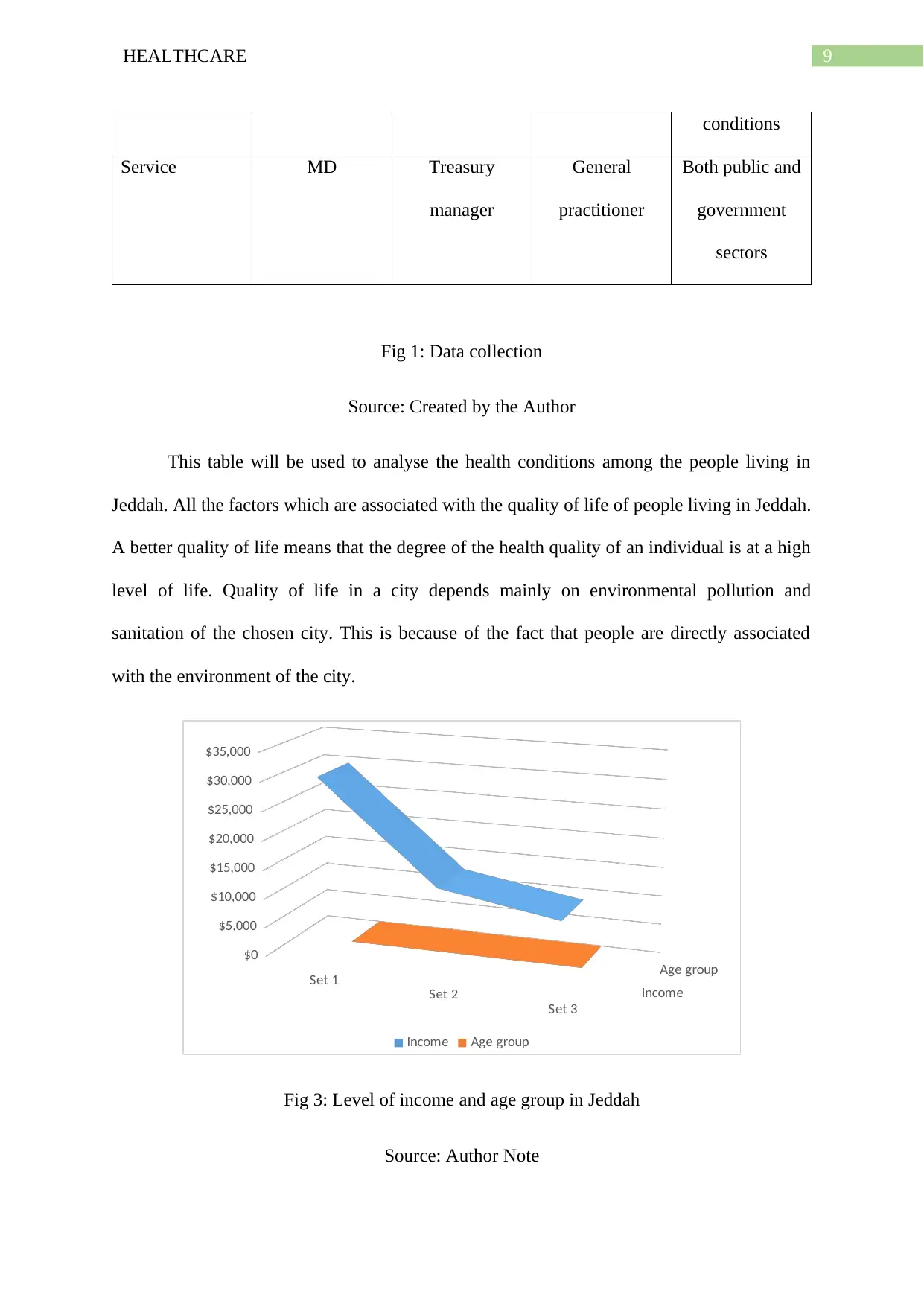
9HEALTHCARE
conditions
Service MD Treasury
manager
General
practitioner
Both public and
government
sectors
Fig 1: Data collection
Source: Created by the Author
This table will be used to analyse the health conditions among the people living in
Jeddah. All the factors which are associated with the quality of life of people living in Jeddah.
A better quality of life means that the degree of the health quality of an individual is at a high
level of life. Quality of life in a city depends mainly on environmental pollution and
sanitation of the chosen city. This is because of the fact that people are directly associated
with the environment of the city.
Set 1
Set 2
Set 3
$0
$5,000
$10,000
$15,000
$20,000
$25,000
$30,000
$35,000
Income
Age group
Income Age group
Fig 3: Level of income and age group in Jeddah
Source: Author Note
conditions
Service MD Treasury
manager
General
practitioner
Both public and
government
sectors
Fig 1: Data collection
Source: Created by the Author
This table will be used to analyse the health conditions among the people living in
Jeddah. All the factors which are associated with the quality of life of people living in Jeddah.
A better quality of life means that the degree of the health quality of an individual is at a high
level of life. Quality of life in a city depends mainly on environmental pollution and
sanitation of the chosen city. This is because of the fact that people are directly associated
with the environment of the city.
Set 1
Set 2
Set 3
$0
$5,000
$10,000
$15,000
$20,000
$25,000
$30,000
$35,000
Income
Age group
Income Age group
Fig 3: Level of income and age group in Jeddah
Source: Author Note
Paraphrase This Document
Need a fresh take? Get an instant paraphrase of this document with our AI Paraphraser
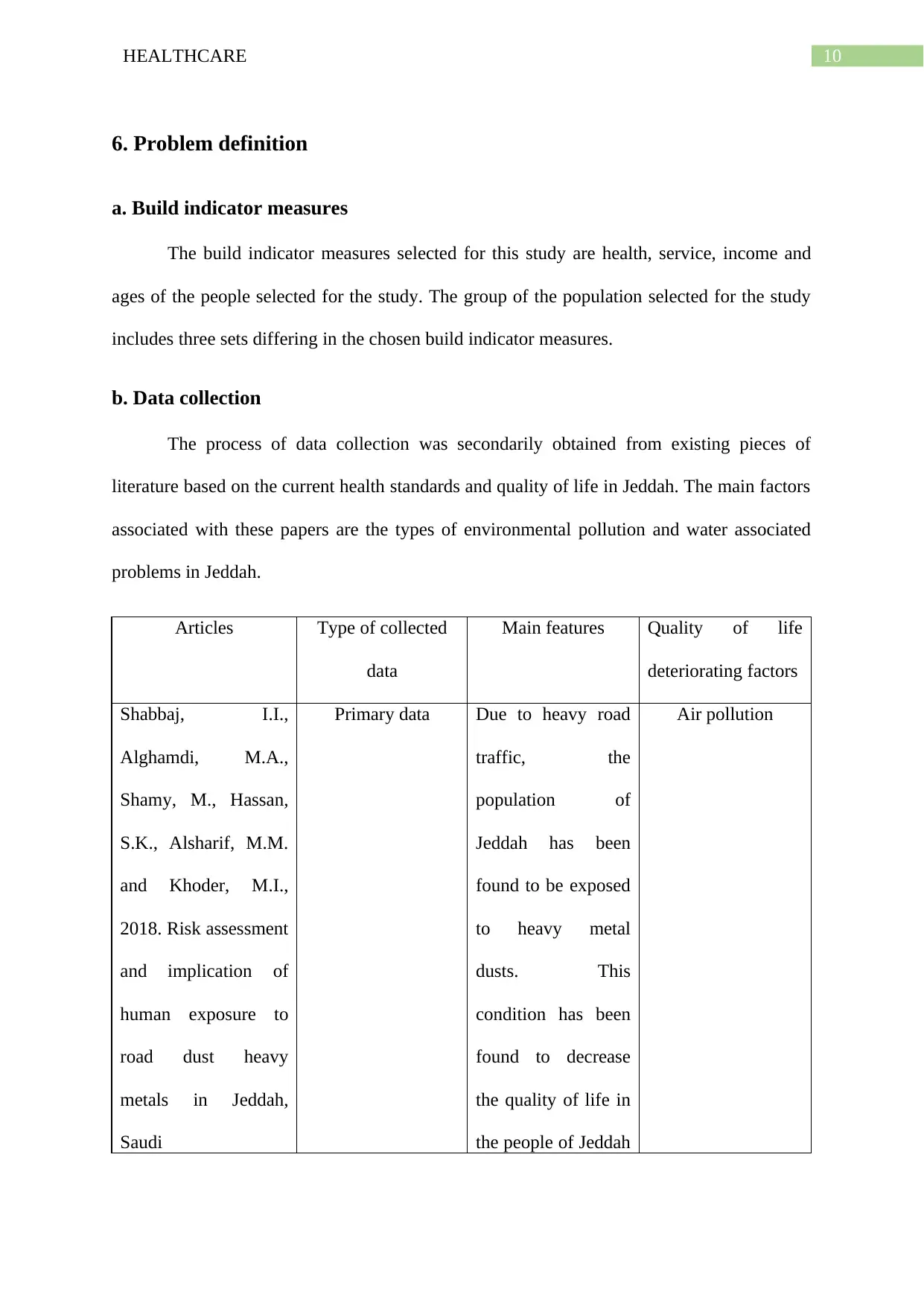
10HEALTHCARE
6. Problem definition
a. Build indicator measures
The build indicator measures selected for this study are health, service, income and
ages of the people selected for the study. The group of the population selected for the study
includes three sets differing in the chosen build indicator measures.
b. Data collection
The process of data collection was secondarily obtained from existing pieces of
literature based on the current health standards and quality of life in Jeddah. The main factors
associated with these papers are the types of environmental pollution and water associated
problems in Jeddah.
Articles Type of collected
data
Main features Quality of life
deteriorating factors
Shabbaj, I.I.,
Alghamdi, M.A.,
Shamy, M., Hassan,
S.K., Alsharif, M.M.
and Khoder, M.I.,
2018. Risk assessment
and implication of
human exposure to
road dust heavy
metals in Jeddah,
Saudi
Primary data Due to heavy road
traffic, the
population of
Jeddah has been
found to be exposed
to heavy metal
dusts. This
condition has been
found to decrease
the quality of life in
the people of Jeddah
Air pollution
6. Problem definition
a. Build indicator measures
The build indicator measures selected for this study are health, service, income and
ages of the people selected for the study. The group of the population selected for the study
includes three sets differing in the chosen build indicator measures.
b. Data collection
The process of data collection was secondarily obtained from existing pieces of
literature based on the current health standards and quality of life in Jeddah. The main factors
associated with these papers are the types of environmental pollution and water associated
problems in Jeddah.
Articles Type of collected
data
Main features Quality of life
deteriorating factors
Shabbaj, I.I.,
Alghamdi, M.A.,
Shamy, M., Hassan,
S.K., Alsharif, M.M.
and Khoder, M.I.,
2018. Risk assessment
and implication of
human exposure to
road dust heavy
metals in Jeddah,
Saudi
Primary data Due to heavy road
traffic, the
population of
Jeddah has been
found to be exposed
to heavy metal
dusts. This
condition has been
found to decrease
the quality of life in
the people of Jeddah
Air pollution
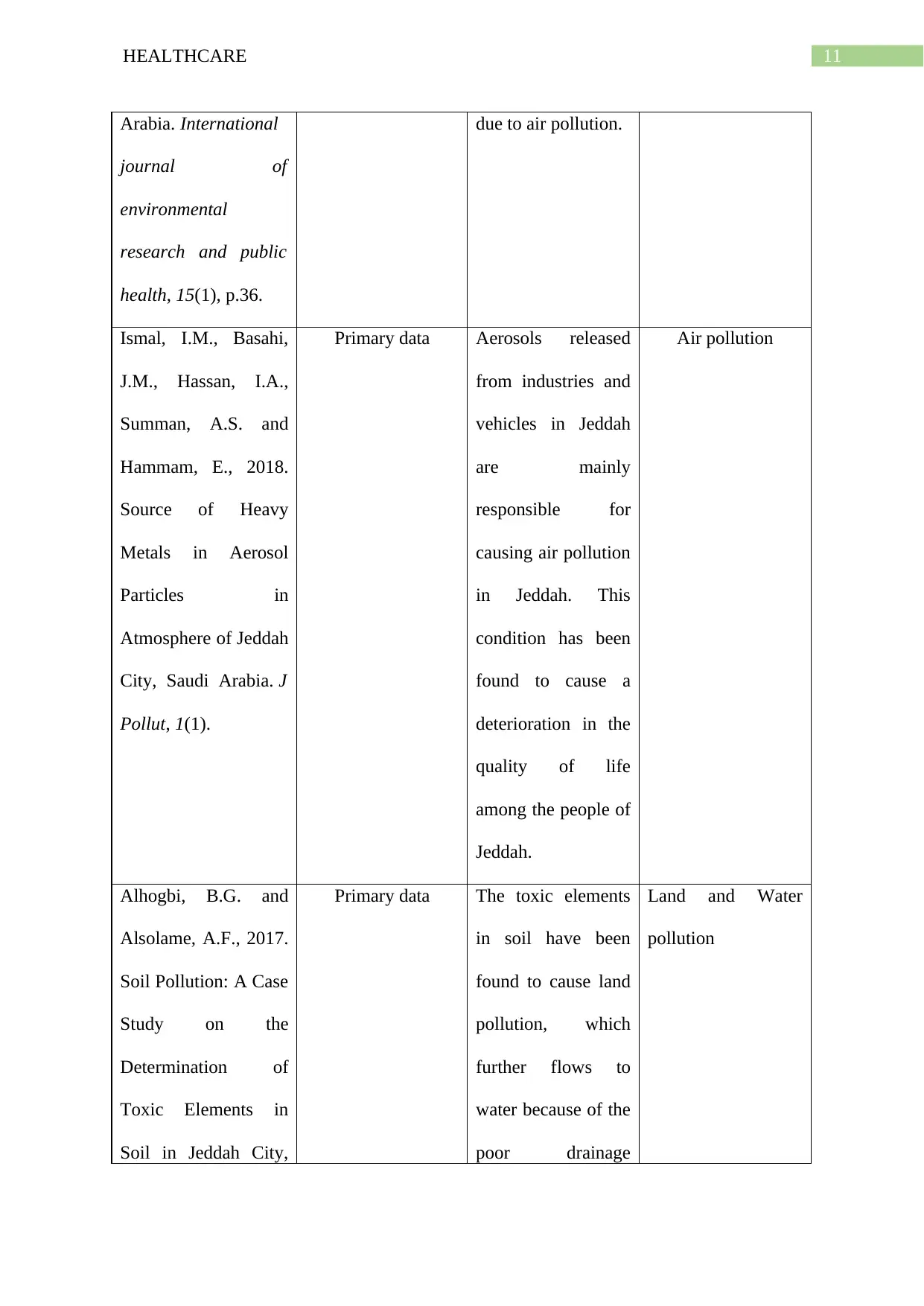
11HEALTHCARE
Arabia. International
journal of
environmental
research and public
health, 15(1), p.36.
due to air pollution.
Ismal, I.M., Basahi,
J.M., Hassan, I.A.,
Summan, A.S. and
Hammam, E., 2018.
Source of Heavy
Metals in Aerosol
Particles in
Atmosphere of Jeddah
City, Saudi Arabia. J
Pollut, 1(1).
Primary data Aerosols released
from industries and
vehicles in Jeddah
are mainly
responsible for
causing air pollution
in Jeddah. This
condition has been
found to cause a
deterioration in the
quality of life
among the people of
Jeddah.
Air pollution
Alhogbi, B.G. and
Alsolame, A.F., 2017.
Soil Pollution: A Case
Study on the
Determination of
Toxic Elements in
Soil in Jeddah City,
Primary data The toxic elements
in soil have been
found to cause land
pollution, which
further flows to
water because of the
poor drainage
Land and Water
pollution
Arabia. International
journal of
environmental
research and public
health, 15(1), p.36.
due to air pollution.
Ismal, I.M., Basahi,
J.M., Hassan, I.A.,
Summan, A.S. and
Hammam, E., 2018.
Source of Heavy
Metals in Aerosol
Particles in
Atmosphere of Jeddah
City, Saudi Arabia. J
Pollut, 1(1).
Primary data Aerosols released
from industries and
vehicles in Jeddah
are mainly
responsible for
causing air pollution
in Jeddah. This
condition has been
found to cause a
deterioration in the
quality of life
among the people of
Jeddah.
Air pollution
Alhogbi, B.G. and
Alsolame, A.F., 2017.
Soil Pollution: A Case
Study on the
Determination of
Toxic Elements in
Soil in Jeddah City,
Primary data The toxic elements
in soil have been
found to cause land
pollution, which
further flows to
water because of the
poor drainage
Land and Water
pollution
⊘ This is a preview!⊘
Do you want full access?
Subscribe today to unlock all pages.

Trusted by 1+ million students worldwide
1 out of 19
Related Documents
Your All-in-One AI-Powered Toolkit for Academic Success.
+13062052269
info@desklib.com
Available 24*7 on WhatsApp / Email
![[object Object]](/_next/static/media/star-bottom.7253800d.svg)
Unlock your academic potential
Copyright © 2020–2025 A2Z Services. All Rights Reserved. Developed and managed by ZUCOL.




